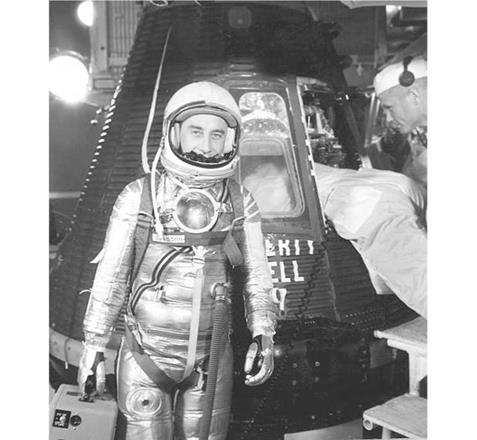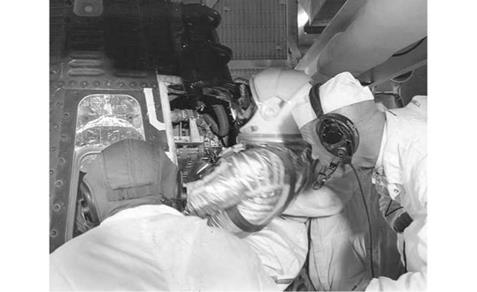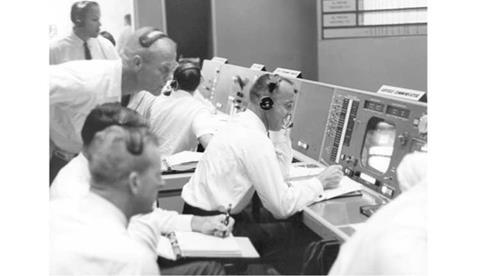LAUNCH PREPARATIONS CONTINUE
When Grissom reached the capsule level, he peered briefly down from a window in the green Plexiglas curtain surrounding the capsule, then disappeared from sight of those on the ground. Surrounding the capsule, as usual, were specialists wearing pure white smocks and white skull caps. McDonnell’s pad leader, Guenter Wendt, was there as he had been for Alan Shepard two months earlier. “I felt very handsome in my clean white jacket, white baseball cap with the word ‘McDonnell’ across the front, my headset, and white shirt with a bow-tie,” Wendt would later recall.1
As Bill Douglas later said of the process of inserting the astronaut into the capsule, “After the pilot climbs into the spacecraft and positions himself in the couch, the
pressure-suit technician [Joe Schmitt] attaches the ventilation hoses, the communication line, the biosensor leads and the helmet visor seal hose, and finally he attaches the restraint harness in position but only fastens it loosely. At this point the suit and environmental control system is purged with 100-percent pure oxygen until such time as analysis of the gas in the system shows the oxygen concentration exceeds 95 percent. When the purge of the suit system is completed, the pressure-suit technician tightens the restraint harness; the flight surgeon [Douglas] makes a final inspection of the interior of the spacecraft and of the pilot, and the hatch installation commences. During the insertion procedures, it is the flight surgeon’s duty to monitor the suit purge procedure and to stand by to assist the pressure-suit technician or the pilot in any way he can. The final inspection of the pilot by the flight surgeon gives some indication of the pilot’s emotional state at the last possible opportunity.”2
|
Grissom prepares for insertion into the waiting spacecraft. (Photo: NASA) |
|
John Glenn assists his fellow astronaut into the tight confines of his spacecraft. (Photo: NASA) |
Once Grissom was settled into his form-fitting couch inside Liberty Bell 7 he was given a reassuring pat on the back by John Glenn, who had once again performed the final checks on the capsule prior to Grissom’s arrival. Then Joe Schmitt completed his tasks, strapping the astronaut in and linking him to the onboard communications and ventilation systems before wishing him good luck and withdrawing. Guenter Wendt and his team then took over.
“After final hookups and adjustments, I shook Gus’ hand and requested the ‘go’ to close the hatch,” Wendt remarked. “In minutes, my technicians were busy torquing down the 70 hatch bolts. One of the bolts got cross-threaded and we called a halt in the count so that engineering management could assess the situation. It was quickly decided that the one bad bolt would not jeopardize proper function of the hatch and the count resumed.”3 After the flight, Grissom was given that bolt as a souvenir.
Despite the lack of space, Grissom felt quite at home within the tight confines of Liberty Bell 7. Countless hours of training – particularly inside the spacecraft – had ensured he was familiar with every switch, system, sound, and countless other facets of the tiny vehicle. “It is good to get into the flight capsule a number of times,” he related in his post-flight briefing. “Then, on launch day, you have no feeling of sitting on top of a booster ready for launch. You feel as if you were back in the checkout hangar – this is home, the surroundings are familiar, you are at ease. You cannot achieve this feeling of familiarity in the procedures trainer because there are inevitably many small differences between the simulator and the capsule.”4
|
Inside the Mercury Control Center, mission CapCom Alan Shepard prepares for the launch of MR-4. (Photo: NASA) |
Meanwhile the tension was slowly building for everyone connected with the flight and the many thousands of people on hand to witness history being made. The Cape and Cocoa Beach areas were slowly coming to life as people woke early, had breakfast, and began gathering on the beaches and every vantage point, nervous but in a state of excited expectation. The news media people started reporting to their assigned pool units, ready to be escorted to the Cape.













